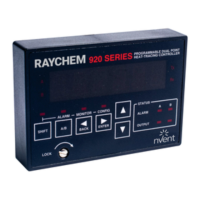49 / 82
EN- Raychem920series-IM-H5687405/15
INDUSTRIAL HEAT TRACING SOLUTIONS
SECTION 5 CONTROL MODES
5.1 INTRODUCTION
There are several types of control modes in the controller. Some of these modes require further
explanation in order to fully understand and implement their operation.
This section describes the control modes available in the HTC and how to set their associated
parameters.
5.2 SWITCH CONTROL MODES
There are four SWITCH CONTROL modes associated with the HTC. The following is an explanation
of their implementation in the controller and the differences between them.
5.2.1 PROPORTIONAL CONTROL (FOR USE WITH SSRS ONLY)
Proportional control on the HTC is implemented as follows:
When using SSRs to directly control the power applied to a trace circuit, the output may be
switched on/off very rapidly. The controller im-plements proportional temperature control on a
cycle-by-cycle basis (50 or 60 Hz power line cycle). This algorithm monitors the temperature of the
heating circuit and compares it to the CONTROL SETPOINT temperature. If the temperature of the
control sensor is at or below the CONTROL SETPOINT temperature, power is applied to the trace
with a duty cycle of 100%—the controller output is full on. If the temperature sensed by the control
sensor is equal to or greater than the CONTROL SETPOINT temperature + the PROPORTIONAL
BAND setting, the controller output will have a duty cycle of 0%—the output will be off. The
temperature of the control sensor is constantly monitored and the output duty cycle is adjusted
proportionally according to where the temperature falls within the 0%–100% band.
Proportional Control Temperature Band
Control Sensor Temperature Duty Cycle
Setpoint + proportional band 0%
Setpoint + proportional band/2 50%
Setpoint 100%
5.2.2 DEADBAND CONTROL (FOR USE WITH EXTERNAL CONTACTORS)
Deadband control on the HTC is implemented as follows:
When using the HTC in an application where the controller is used to open and close a contactor,
proportional control cannot be used. In these cases a deadband control algorithm is used. The
outputdutycycleisnotcontrolled;instead,theoutputiseitherfullyonorcompletelyoff.Theuser
can set the DEADBAND value. The controller monitors the temperature of the trace circuit and
compares it to the CONTROL SETPOINT temperature as in the proportional control. If the control
sensor temperature is above the CONTROL SETPOINT temperature by more than the DEADBAND
value, the output is turned off. If the control sensor temperature falls below the CONTROL
SETPOINT temperature the output is turned on. This is a simple control algorithm but it works
very effectively in heat trace applications where the temperature of a traced system changes
relatively slowly.
Deadband Control Temperature Band
Control Sensor Temperature Output State
Setpoint + deadband Off
Setpoint On
When the control sensor temperature is within the deadband, the output does not change its
state. Also, when using deadband control a contactor is not allowed to toggle faster than every two
seconds. If an AC alarm with an alarm filter time greater than 0 is detected, the contactor will not
toggle until the alarm filter time has expired.

